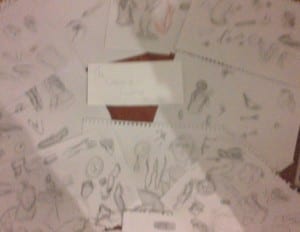My role in the performance was to draw the live art in front of me. I was using different shades of pencils and ordinary paper. In an extreme case it is possible that to say that I am drawing a ‘life drawing’. “The representation of a life-model – and the particular choice of a female model – generates socially and culturally specific associations” (Roberts 2012, p70). In this instant Amanda Roberts suggests that having a female model has significance in society. It certainly does in our piece. As I have said before I am the only male in my group and I am drawing a group of girls. Does this have some sort of patriarchal view on society? Or is it men’s eyes that I represent observing beauty and drawing it – similarly to what the artist did when he drew the Venus de Milo.
Here are the selection of drawings from past rehearsals and the final performance:
It is clear that as the performance progressed the drawings became more erratic. These drawings are shown at the bottom of the photo. This happened as the girls became more frantic with their make-up. This could show men’s dominance over women or a power in art through live drawings or It could show elements of females able to exploit men’s need for a woman. But of course literally similarly to the artist who drew the Venus de Milo they are copies of beauty. Whether my drawings are accurate is irrelevant because it is quite possible the artist’s drawings at as accurate to the Venus de Milo statue; and of course the statue itself it a copy of the Ancient Greek goddess Aphrodite. How did the creator of the statue, Alexandros of Antioch, know that was what she looked like? The drawings themselves were they drawings of ‘true beauty’? Or were they drawings of what was there? This of course leaves our project open as said before what is idealisation, the romantic era of paintings where it was painting for aesthetic sake, and what is true nowadays?…
Works Cited
Roberts, Amanda and Howard Riley (2012) ‘The social semiotic potential of gestural drawing’, Journal of Visual Art Practice, 11 (1) 63-73
